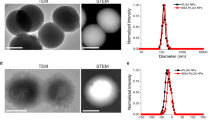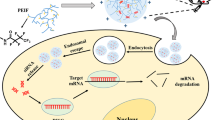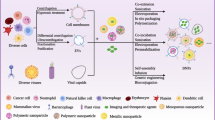Abstract
For successful cancer gene therapy via intravenous (i.v.) administration, it is essential to optimize the stability of carriers in the systemic circulation and the cellular association after the accumulation of the carrier in tumor tissue. However, a dilemma exists regarding the use of poly(ethylene glycol) (PEG), which is useful for conferring stability in the systemic circulation, but is undesirable for the cellular uptake and the following processes. We report the development of a PEG-peptide-lipid ternary conjugate (PEG-Peptide-DOPE conjugate (PPD)). In this strategy, the PEG is removed from the carriers via cleavage by a matrix metalloproteinase (MMP), which is specifically expressed in tumor tissues. An in vitro study revealed that the PPD-modified gene carrier (Multifunctional Envelope-type Nano Device: MEND) exhibited pDNA expression activity that was dependent on the MMP expression level in the host cells. In vivo studies further revealed that the PPD was potent in stabilizing MEND in the systemic circulation and facilitating tumor accumulation. Moreover, the i.v. administration of PPD or PEG/PPD dually-modified MEND resulted in the stimulation of pDNA expression in tumor tissue, as compared with a conventional PEG-modified MEND. Thus, MEND modified with PPD is a promising device, which has the potential to make in vivo cancer gene therapy achievable.
This is a preview of subscription content, access via your institution
Access options
Subscribe to this journal
Receive 12 print issues and online access
$259.00 per year
only $21.58 per issue
Buy this article
- Purchase on Springer Link
- Instant access to full article PDF
Prices may be subject to local taxes which are calculated during checkout







Similar content being viewed by others
References
Ogris M, Brunner S, Schuller S, Kircheis R, Wagner E . PEGylated DNA/transferrin-PEI complexes: reduced interaction with blood components, extended circulation in blood and potential for systemic gene delivery. Gene Therapy 1999; 6: 595–605.
Zhang YP, Sekirov L, Saravolac EG, Wheeler JJ, Tardi P, Clow K et al. Stabilized plasmid-lipid particles for regional gene therapy: formulation and transfection properties. Gene Therapy 1999; 6: 1438–1447.
Kogure K, Moriguchi R, Sasaki K, Ueno M, Futaki S, Harashima H . Development of a non-viral multifunctional envelope-type nano device by a novel lipid film hydration method. J Control Release 2004; 98: 317–323.
Kamiya H, Akita H, Harashima H . Pharmacokinetic and pharmacodynamic considerations in gene therapy. Drug Discov Today 2003; 8: 990–996.
Khalil IA, Kogure K, Futaki S, Harashima H . High density of octaarginine stimulates macropinocytosis leading to efficient intracellular trafficking for gene expression. J Biol Chem 2006; 281: 3544–3551.
Moriguchi R, Kogure K, Akita H, Futaki S, Miyagishi M, Taira K et al. A multifunctional envelope-type nano device for novel gene delivery of siRNA plasmids. Int J Pharm 2005; 301: 277–285.
Tandia BM, Vandenbranden M, Wattiez R, Lakhdar Z, Ruysschaert JM, Elouahabi A . Identification of human plasma proteins that bind to cationic lipid/DNA complex and analysis of their effects on transfection efficiency: implications for intravenous gene transfer. Mol Ther 2003; 8: 264–273.
Allen TM, Hansen C . Pharmacokinetics of stealth versus conventional liposomes: effect of dose. Biochim Biophys Acta 1991; 1068: 133–141.
Torchilin VP . Recent advances with liposomes as pharmaceutical carriers. Nat Rev Drug Discov 2005; 4: 145–160.
Matsumura Y, Maeda H . A new concept for macromolecular therapeutics in cancer chemotherapy: mechanism of tumoritropic accumulation of proteins and the antitumor agent smancs. Cancer Res 1986; 46: 6387–6392.
Oupicky D, Ogris M, Howard KA, Dash PR, Ulbrich K, Seymour LW . Importance of lateral and steric stabilization of polyelectrolyte gene delivery vectors for extended systemic circulation. Mol Ther 2002; 5: 463–472.
Mishra S, Webster P, Davis ME . PEGylation significantly affects cellular uptake and intracellular trafficking of non-viral gene delivery particles. Eur J Cell Biol 2004; 83: 97–111.
Ambegia E, Ansell S, Cullis P, Heyes J, Palmer L, MacLachlan I . Stabilized plasmid-lipid particles containing PEG-diacylglycerols exhibit extended circulation lifetimes and tumor selective gene expression. Biochim Biophys Acta 2005; 1669: 155–163.
Choi JS, MacKay JA, Szoka Jr FC . Low-pH-sensitive PEG-stabilized plasmid-lipid nanoparticles: preparation and characterization. Bioconjug Chem 2003; 14: 420–429.
Kirpotin D, Hong K, Mullah N, Papahadjopoulos D, Zalipsky S . Liposomes with detachable polymer coating: destabilization and fusion of dioleoylphosphatidylethanolamine vesicles triggered by cleavage of surface-grafted poly(ethylene glycol). FEBS Lett 1996; 388: 115–118.
Shin J, Shum P, Thompson DH . Acid-triggered release via dePEGylation of DOPE liposomes containing acid-labile vinyl ether PEG-lipids. J Control Release 2003; 91: 187–200.
Tomlinson R, Heller J, Brocchini S, Duncan R . Polyacetal-doxorubicin conjugates designed for pH-dependent degradation. Bioconjug Chem 2003; 14: 1096–1106.
Walker GF, Fella C, Pelisek J, Fahrmeir J, Boeckle S, Ogris M et al. Toward synthetic viruses: endosomal pH-triggered deshielding of targeted polyplexes greatly enhances gene transfer in vitro and in vivo. Mol Ther 2005; 11: 418–425.
Zhang JX, Zalipsky S, Mullah N, Pechar M, Allen TM . Pharmaco attributes of dioleoylphosphatidylethanolamine/cholesterylhemisuccinate liposomes containing different types of cleavable lipopolymers. Pharmacol Res 2004; 49: 185–198.
Turk BE, Huang LL, Piro ET, Cantley LC . Determination of protease cleavage site motifs using mixture-based oriented peptide libraries. Nat Biotechnol 2001; 19: 661–667.
Mott JD, Werb Z . Regulation of matrix biology by matrix metalloproteinases. Curr Opin Cell Biol 2004; 16: 558–564.
Coussens LM, Fingleton B, Matrisian LM . Matrix metalloproteinase inhibitors and cancer: trials and tribulations. Science 2002; 295: 2387–2392.
Ishii T, Yamada M, Hirase T, Nagasaki Y . New synthesis of heterobifunctional poly (ethylene glycol) possessing a pyridyl disulfide at one end and a carboxylic acid at the other end. Polym J 2005; 37: 221–228.
Holland JW, Cullis PR, Madden TD . Poly(ethylene glycol)-lipid conjugates promote bilayer formation in mixtures of non-bilayer-forming lipids. Biochemistry 1996; 35: 2610–2617.
Masuda T, Akita H, Harashima H . Evaluation of nuclear transfer and transcription of plasmid DNA condensed with protamine by microinjection: the use of a nuclear transfer score. FEBS Lett 2005; 579: 2143–2148.
Sorgi FL, Bhattacharya S, Huang L . Protamine sulfate enhances lipid-mediated gene transfer. Gene Therapy 1997; 4: 961–968.
Miyamori H, Takino T, Kobayashi Y, Tokai H, Itoh Y, Seiki M et al. Claudin promotes activation of pro-matrix metalloproteinase-2 mediated by membrane-type matrix metalloproteinases. J Biol Chem 2001; 276: 28204–28211.
Sato H, Kida Y, Mai M, Endo Y, Sasaki T, Tanaka J et al. Expression of genes encoding type IV collagen-degrading metalloproteinases and tissue inhibitors of metalloproteinases in various human tumor cells. Oncogene 1992; 7: 77–83.
Stein Y, Halperin G, Stein O . Biological stability of [3H]cholesteryl oleyl ether in cultured fibroblasts and intact rat. FEBS Lett 1980; 111: 104–106.
Kircheis R, Blessing T, Brunner S, Wightman L, Wagner E . Tumor targeting with surface-shielded ligand–polycation DNA complexes. J Control Release 2001; 72: 165–170.
Ogris M, Walker G, Blessing T, Kircheis R, Wolschek M, Wagner E . Tumor-targeted gene therapy: strategies for the preparation of ligand–polyethylene glycol–polyethylenimine/DNA complexes. J Control Release 2003; 91: 173–181.
Schiffelers RM, Ansari A, Xu J, Zhou Q, Tang Q, Storm G et al. Cancer siRNA therapy by tumor selective delivery with ligand-targeted sterically stabilized nanoparticle. Nucleic Acids Res 2004; 32: e149.
Lee ES, Na K, Bae YH . Doxorubicin loaded pH-sensitive polymeric micelles for reversal of resistant MCF-7 tumor. J Control Release 2005; 103: 405–418.
Martin GR, Jain RK . Fluorescence ratio imaging measurement of pH gradients: calibration and application in normal and tumor tissues. Microvasc Res 1993; 46: 216–230.
Tsuji A, Yoshikawa T, Nishide K, Minami H, Kimura M, Nakashima E et al. Physiologically based pharmacokinetic model for beta-lactam antibiotics I: Tissue distribution and elimination in rats. J Pharm Sci 1983; 72: 1239–1252.
Hatakeyama H, Akita H, Maruyama K, Suhara T, Harashima H . Factors governing the in vivo tissue uptake of transferrin-coupled polyethylene glycol liposomes in vivo. Int J Pharm 2004; 281: 25–33.
Acknowledgements
This work was supported by a Grant-in-Aid for Exploratory Research from the Japan Society for the Promotion of Sciences (JSPS). We thank Dr MS Feather for his helpful advice concerning the English in this manuscript.
Author information
Authors and Affiliations
Corresponding author
Additional information
Supplementary Information accompanies the paper on Gene Therapy website (http://www.nature.com/gt)
Rights and permissions
About this article
Cite this article
Hatakeyama, H., Akita, H., Kogure, K. et al. Development of a novel systemic gene delivery system for cancer therapy with a tumor-specific cleavable PEG-lipid. Gene Ther 14, 68–77 (2007). https://doi.org/10.1038/sj.gt.3302843
Received:
Revised:
Accepted:
Published:
Issue Date:
DOI: https://doi.org/10.1038/sj.gt.3302843
Keywords
This article is cited by
-
Effect of the side chain composition of mixed-charge polymers on pH-selective cell–membrane interactions
Polymer Journal (2023)
-
Structure and Function of Cationic and Ionizable Lipids for Nucleic Acid Delivery
Pharmaceutical Research (2023)
-
Obstacles and opportunities in a forward vision for cancer nanomedicine
Nature Materials (2021)
-
PEGylation: a promising strategy to overcome challenges to cancer-targeted nanomedicines: a review of challenges to clinical transition and promising resolution
Drug Delivery and Translational Research (2019)



